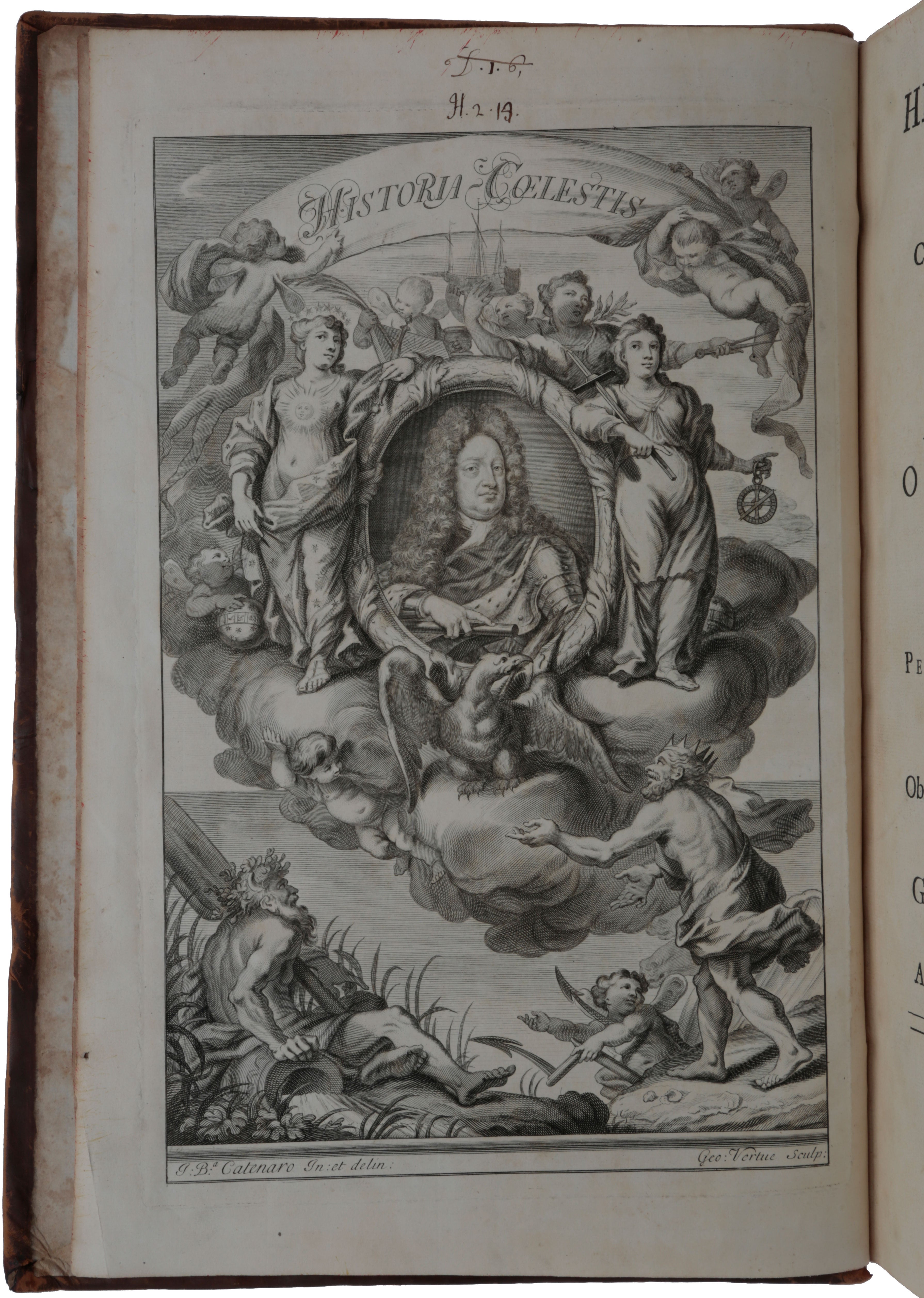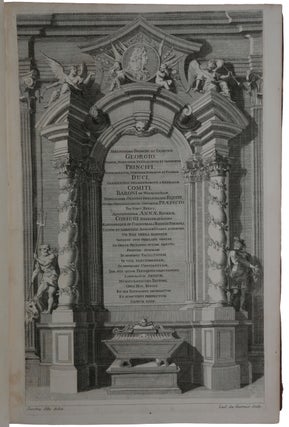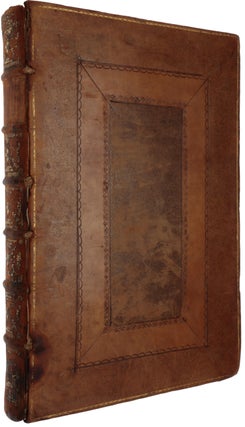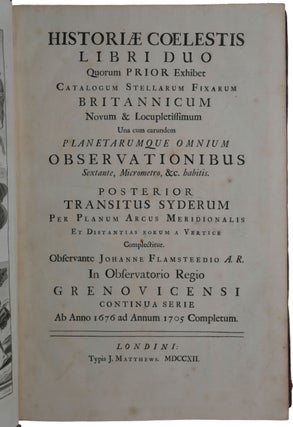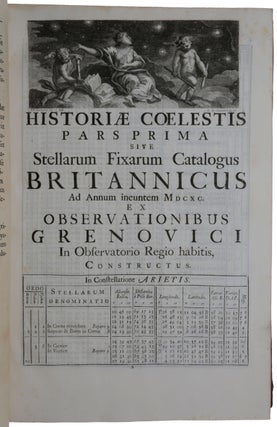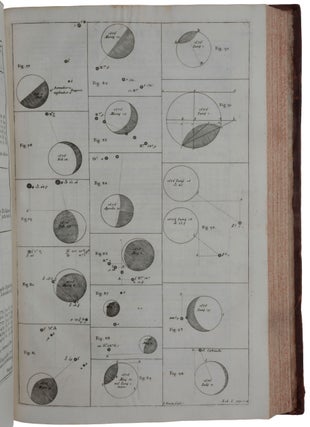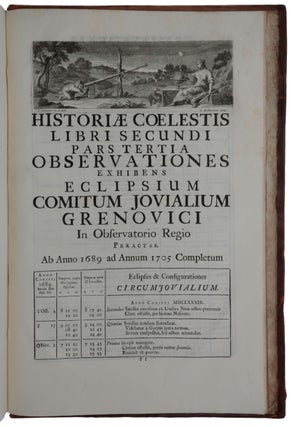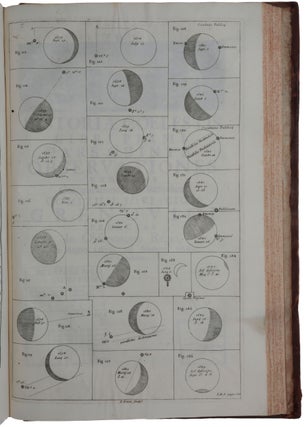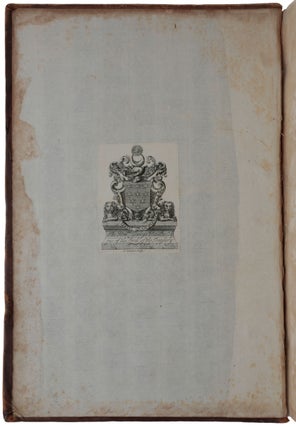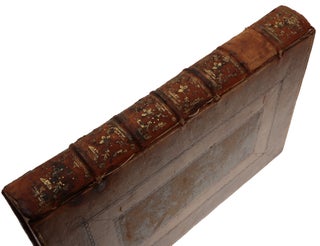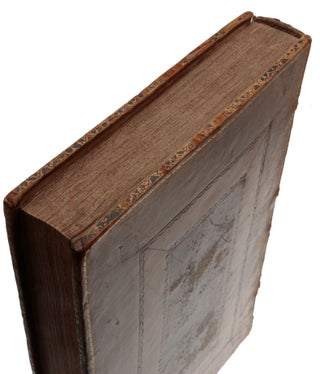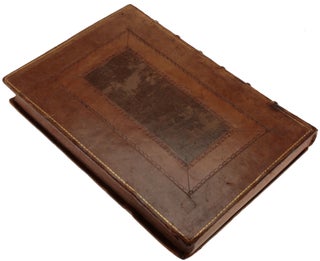Historiae coelestis libri duo: quorum prior exhibet catalogum stellarum fixarum Britannicum novum & locupletissimum, ... Observante Johanne Flamsteedio in Observatorio Regio Grenovicensi continua serie ab anno 1676 ad annum 1705 completum.
London: John Matthews, 1712. The true first edition, extremely rare, of Flamsteed’s catalogue of fixed stars and sextant observations, the foundation of modern observational astronomy; this copy was probably bound for Queen Anne (please see below). Flamsteed’s catalogue was far more extensive and accurate than anything that had gone before. It was the first constructed with instruments using telescopic sights and micrometer eyepieces; Flamsteed was the first to study systematic errors in his instruments; he was the first to urge the fundamental importance of using clocks and taking meridian altitudes; and he insisted on having assistants to repeat the observations and the calculations. The catalogue contains about 3000 naked eye stars (Ptolemy and Tycho listed 1000, Hevelius 2000) with an accuracy of about 10 seconds of arc. However, Flamsteed, although appointed Astronomer Royal in 1675, by the turn of the eighteenth century had still not published any of his observations. Isaac Newton and Edmond Halley pressed him to do so; Flamsteed’s refusal led to one of the most famous, and bitterest, disputes in the history of astronomy, and to the present work being published against Flamsteed’s will. Flamsteed’s response, in 1716, was to destroy 300 of the 400 copies printed, so just a few years after publication no more than 100 copies survived. Flamsteed published his own, ‘authorised’, version of his star catalogue in 1725. Provenance: The Hon. George Baillie (1664–1738), a Lord of the Treasury, with manuscript shelf-mark on blank margin of frontispiece. Baillie was a leading member of the Squadrone Volante, a group of members who were influential in the debates which led to the union with England in 1707. In 1711, he was appointed Commissioner for Trade and Plantations by Queen Anne. “Born a somewhat sickly child at Denby, near Derby, Flamsteed’s condition seems to have worsened in 1660 by what sounds like an attack of rheumatic fever. He was taken away from school and devoted himself to the study of mathematics and astronomy. A visit to Ireland in 1665 to be touched by Vincent Greatrakes, a famous healer of the day as a seventh son of a seventh son, had no effect upon his health. Shortly afterwards, however, his work began to be noticed by a number of Fellows of the Royal Society. Amongst these was Sir Jonas Moore, who was considering building a private observatory for Flamsteed. It proved unnecessary, for in 1675 Flamsteed was appointed to be the first Astronomer Royal by Charles II. As the first holder of the post, Flamsteed was responsible for the building and organisation of the new observatory at Greenwich. He also found that on a salary of £100 a year he was expected to engage and pay his own staff, and to provide his own instruments. Although some instruments were donated by Moore and others, Flamsteed still found it necessary to spend £120 of his own money on a mural arc. Made and divided by Abraham Sharp it was ready for use in September 1689. As a result of this expenditure, all observations made after 1689 seemed to Flamsteed to be unarguably his own property, and his to do with as he willed. “He met Newton for the first time in Cambridge in 1674. The first substantial issue between them arose over the nature of the comet of 1680-1. Newton was convinced that two comets were present and in letters to Flamsteed argued so at length. Flamsteed, however, insisted only one comet was present, a position Newton finally accepted in September 1685. Relations remained cordial and in 1687 Flamsteed was one of the few scholars selected to receive a presentation copy of Principia. It contained, he noted, only ‘very slight acknowledgements’ to his Greenwich observations. “On 1 September 1694 Newton paid his first visit to Greenwich. He spoke with Flamsteed about the moon. Newton was keen to examine Flamsteed’s lunar data in order to correct and improve the lunar theory presented in Principia. Flamsteed offered to loan Newton 150 ‘places of the moon’ on two conditions: firstly, that Newton would not show the work to anyone else; secondly, and more unreasonably, Newton would have to agree not to reveal any results derived from Flamsteed’s observations to any other scholar. It was the beginning of an ill-tempered dispute which would last until Flamsteed’s death. His own version of the quarrel is contained in his History of his own Life and Labors published in Baily (An Account of the Revd John Flamsteed (1966), pp. 7-105). It is a most bitter document. “None of Newton’s proposals found favour with Flamsteed. The offer in November 1694 ‘to gratify you to your satisfaction’ brought the answer that he was not tempted with ‘covetousness’ and the lament that Newton could have ever thought so meanly of him. An offer in 1695 to pay Flamsteed’s scribe two guineas for his transcriptions brought an equally forthright rejection. It was enough, Newton was told, to offer ‘verball acknowledgements’; a ‘superfluity of monys’, he found, ‘is always pernicious to my Servants it makes them run into company and wast their time Idly or worse’. If Newton asked for ‘your Observations only’, Flamsteed complained of being treated like a drudge; if, however, calculations were asked for as well, Flamsteed would respond that such work required all kinds of tedious analysis for which he had little time … “Over the period 1694-5 Newton received another 150 observations. They were, however, none too reliable, having been made with the help of a stellar catalogue constructed with the help of a sextant alone. By this time Flamsteed was beginning to resent Newton’s somewhat imperial tone. ‘But I did not think myself obliged’, he complained, ‘to employ my pains to serve a person that was so inconsiderate as to presume he had a right to that which was only a courtesy (Baily, p. 63). Consequently, he returned to his own work, leaving Newton to work through the observations he had already received. “The two continued to see each other and to discuss Flamsteed’s lunar observations until January 1699. This part of the correspondence ends with Flamsteed lecturing Newton on pride and humility. His own humility, he proudly told Newton, allowed him to ‘excuse small faults in all mankind’, and to ‘bear great injurys without resentment’. “The second stage of the dispute began on 11 April 1704 with a visit by Newton to Greenwich. Newton had yet to complete his lunar theory and could scarcely have looked forward to the prospect of another prolonged quarrel with Flamsteed. He seems to have decided to attempt to resolve the problem in a more direct manner. Using his position as President of the Royal Society, and his connections at Court, he sought to pressurise Flamsteed into publishing his long-awaited catalogue, thus putting all his observations into the public domain. The approach was rejected. Newton, Flamsteed noted, was too obviously someone who ‘would be my friend no further than to serve his own ends … spiteful, and swayed by those that were worse than himself’ (Baily, p. 66). “Newton went over Flamsteed’s head and gained the backing of Prince George, husband to Queen Anne, for the project. Scientists in the eighteenth century did not reject the offer of royal patronage. Consequently, Flamsteed in November drew up an estimate of his three-volume catalogue. The work would be 1,450 pages long and the printing of the first volume could begin immediately. Unwilling to leave the task to Flamsteed, Newton arranged instead for a Committee of Referees to examine Flamsteed’s papers and to oversee publication. The members of the Committee were either, like Francis Aston and David Gregory, Newton’s men or, like Sir Christopher Wren, too old and busy to concern themselves with such a task. Newton also extracted from Prince George the sum of £863 to finance the project. It soon became clear that Newton and Flamsteed had different visions of the planned work. Flamsteed had hoped to present his work within a detailed historical context by including in the third volume, along with his own stellar catalogue, all important earlier catalogues from Ptolemy to Hevelius. He also wished to add a celestial atlas consisting of sixty large star-charts. Newton’s aim was much more restricted and consisted of no more than completing and publishing Flamsteed’s observations. “Flamsteed could do little more than delay the project. In this he was quite successful as by 1708, when Prince George died, the first volume was still incomplete. With the death of Prince George the Referees no longer had control over Flamsteed’s text. Newton’s response was to have himself, as President of the Royal Society, appointed in 1710 a ‘constant Visitor’ to the Greenwich Observatory, with access to all observations and the right to direct the work of the Astronomer Royal. Shortly afterwards Flamsteed heard that the Queen had commanded him to hand over all outstanding material and so allow the work to be finally completed. “It finally appeared in 1712, edited by Halley, as Historiae coelestis (History of the Heavens). It was not to Flamsteed’s liking, seeming to him to be no more than a parody of the work he had once dreamed of publishing. Equally distressing to him was the fact that it had been produced by Halley, a man he despised as an atheist, a libertine and a plagiarist (Baily, p. xxxi)” (Gjertsen, pp. 209-212). Four hundred copies of Halley’s edition were printed. In the period 1699–1701, Flamsteed had begun to draw up pages listing stars in the zodiacal constellations, working his way through Orion and Monoceros to Lyra and Cygnus. After a hiatus of several years, Flamsteed began in August 1708 till January 1709 to work up some of the remaining constellations such as Ursa Minor and Draco. “Generally [Halley] preserved Flamsteed’s order of the stars and constellations, so that his final product looked much like the lists Flamsteed had originally submitted. Halley numbered the stars in each constellation, and arranged them in groups of five instead of the triplets used by Flamsteed … However, the most conspicuous systematic alterations concerned the verbal descriptions of the places of the stars within the mythological constellation figures. Foe example, Halley always changed Flamsteed’s use of dexter or sinister to less ambiguous words such as sequens, praecedens, superior or Boreus. The 1725 edition reverted to Flamsteed’s original description, but, in retrospect, Halley’s terminology seems generally preferable. Halley’s other major task was the completion of the six northern constellations, among them Ursa Major, Ursa Minor, Cepheus, Draco and Cassiopeia … “Ironically, one of the features of the ‘corrupted’ 1712 edition that Flamsteed rejected were the serial numbers for the stars in each constellation, a convenience added by Halley, and in its revised form regularly employed by astronomers today. Flamsteed omitted such numbers from the ‘authorised’ 1725 edition and his atlas … Thus, the familiar ‘Flamsteed numbers’, which eponymises the First Astronomer Royal for hundreds of amateur astronomers who might never otherwise have heard of him, were actually an invention spurned by the ever-proper Revd. John Flamsteed” (Gingerich, pp. 195-7). With the accession of George I in 1714 Flamsteed found that at last he had friends at Court. “On his petition, Flamsteed was accordingly awarded a warrant ordering that of the 340 copies of the 1712 Historia coelestis still in the hands of [the printer] Awnsham Churchill, 300 should be handed over to him ‘as a present from his Majty’. After a long delay, the copies were delivered. Flamsteed immediately took them to Greenwich. There he separated out the section printed when he had still been able to correct the press, setting aside ‘Halley’s corrupted edition of my catalogue, and [his] abridgement of my observations, no less spoiled by him.’ He kept the former to be inserted into the edition he himself still hoped to complete. A few copies of the latter he annotated and sent to friends, as cautionary ‘Evidence of ye malice of Godlesse persons’. But in spring 1716 Flamsteed built a pyre on Greenwich Hill, and burned the sheets containing the catalogue and abridged observations. As he himself put it, they made a good ‘sacrifice to TRUTH.’ He would do the same to ‘all the rest of my editor’s pains of the like nature,’ he declared, ‘if the Author of Truth should hereafter put them into my power.’ “If 340 copies remained, some 60 had been distributed. Along with the remaining books, the government also demanded a full account of the dispersal of these copies. The account made clear that, as had always been intended, the first copies of the Historia coelestis were not published in a commercial sense. Instead they had been envisaged as royal ‘presents’, to be given to a selective list of recipients … More than fifty of the copies no longer in Churchill’s warehouse had been dispersed. Ten had gone to courtiers, thirty to the Treasury (richly bound for use as diplomatic gifts), and ten more to the observatory and Royal Academy in Paris. Newton and Halley had got one each, Flamsteed two” (Johns, pp. 607-9). For the rest of his life Flamsteed laboured on, and the work was completed, after his death, by his former assistants resulting in a publication containing a revised catalogue, more observations and reprints of earlier star catalogues to compare with Flamsteed’s own. This was the Historia coelestis Britannica published in 1725, much as Flamsteed had wanted it, except for the omission of the details of his quarrels with Newton and Halley, which he had wanted to include. The atlas, which he originally intended to publish with the catalogue, was issued separately in 1729. Flamsteed only burnt Halley’s preface and the catalogue from the 1712 work, re-using the sextant observations, the proofs of which he had corrected before the final rift with the Royal Society. This means that no more than the 100 copies of the 1712 work already issued can have remained, and no more than 300 copies of the 1725 work issued. Flamsteed continued to attempt to round up copies of the 1712 work and left instructions for his widow to do the same. She even wrote to the Vice-Chancellor of Oxford University in 1726 politely asking him to have the 1712 work removed from the Bodleian Library (he declined). The copy of Flamsteed’s Historia coelestis in the Linda Hall Library bears the gilt arms of Queen Anne (1664-1714, reigned 1702-1707). Although her arms are not present on our copy, the binding and endpapers are otherwise so similar to those of the Linda Hall copy that it seems probable that our copy was also bound for her. She may have presented the copy to George Baillie, whom she had appointed Commissioner for Trade and Plantations the year before the present work was published. It is recorded that 15 copies were bound in ‘calf skin, gilt and filleted’ by Awnsham Churchill for use as diplomatic gifts – see the July 19 entry in: Calendar of Treasury Books, Volume 29, 1714-1715, Warrant Books: July 1715, 16-20, pp. 639-647 (https://www.british-history.ac.uk/cal-treasury-books/vol29/pp639-647). Gingerich, ‘A unique copy of Flamsteed’s Historia Coelestis,’ pp. 189-197 in Flamsteed’s Stars: New Perspectives on the Life and Work of the First Astronomer Royal, 1646-1719 (Willmoth, ed.) (1997); Gjertsen, The Newton Handbook (1986); Johns, The Nature of the Book: Print and Knowledge in the Making (1998).
Large folio (386 x 255 mm), pp [ii] vi 60; 387 [1, blank]; [2, sectional title] 120, [2, errata], with engraved frontispiece, engraved dedication leaf, ten engraved headpieces, and four engraved plates; a few minor marginal tears not affecting text, a fine, crisp, unrestored copy in contemporary panelled calf, joints cracked but boards holding and spine rubbed and worn.
Item #5074
Price: $140,000.00

